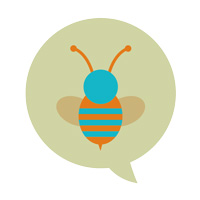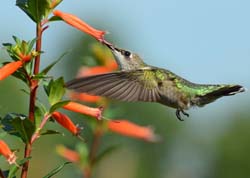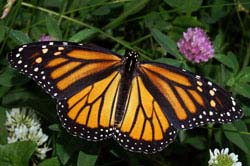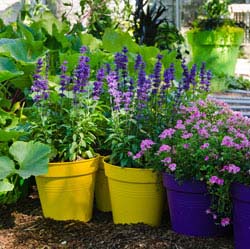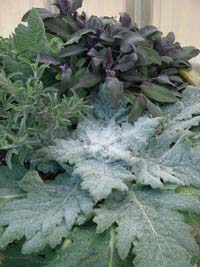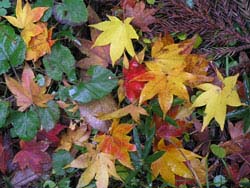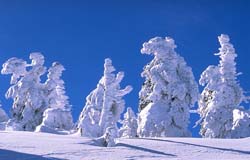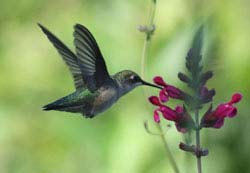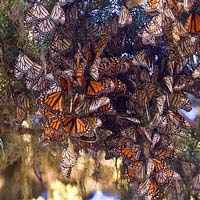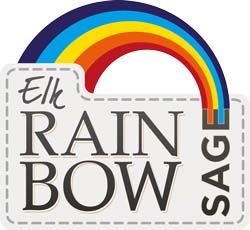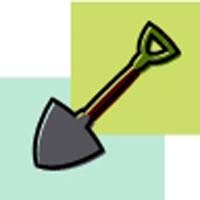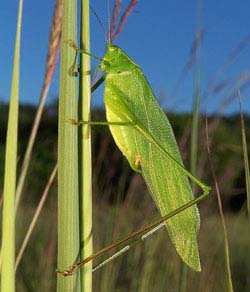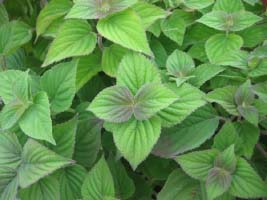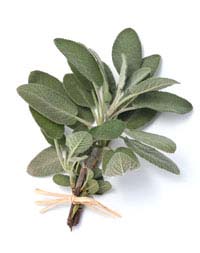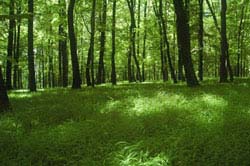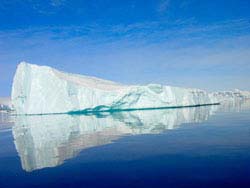
We began publishing our Everything Salvias blog in 2010 for your enjoyment and to help you "get it right" when growing sages that are often unavailable at local garden centers.
It seems like there is an endless bounty of stories to be told. But that's to be expected when covering a genus containing an estimated 900 species -- the largest group within the mint family (Lamiaceae). In addition to Salvias, we write about other species that are either mint family members or low-water companions for our many drought-tolerant Salvias. We welcome comments as well as suggestions for future blog posts.
To access articles rapidly based on your interests, please click on the categories below, which include do-it-yourself videos (Views from the Garden). But please note: This is a dangerous place for a sage lover.
| Explore the Categories: | ||||
| | | | | |
| | | | | |
| | | | | |
| | | | | |
| | | |||
Posted: Sunday, December 15, 2013
Synopsis:
Bright orange, tube-shaped blossoms cover Cuphea x 'David Verity' like tiny windsocks blowing in a breeze and beckoning hummingbirds. Similar to Salvias, Cupheas are rich sources of nectar that fuel hummingbird migration. At Flowers by the Sea, we are always interested in expanding choices for creating wildlife habitat. So we are growing a wide variety of Cupheas for sale this coming spring, including David Verity.
Read the Article
Posted: Tuesday, November 19, 2013
Synopsis:
Flowers by the Sea uses a customized system for shipping charges. Customized fees allow adjustment of shipping prices based on how far away you live from FBTS and how many plants you purchase. This is a more equitable way of covering delivery fees instead of increasing plant prices to cover losses on delivery charges as in a flat-rate system.
Read the Article
Posted: Thursday, October 31, 2013
Synopsis:
Declining numbers of Monarch butterflies is an ongoing problem. Due to research by organizations such as Monarch Watch and the Xerces Society as well as tracking efforts by the Mexican government, we now know about the dramatic ups and downs the species has experienced in the past 20 years. At Flowers by the Sea Online Nursery, we grow butterfly favorites to help you plant gardens supporting the migration of Monarchs and other butterflies.
Read the Article
Posted: Thursday, October 24, 2013
Synopsis:
As autumn days become shorter, so does time for protecting all your tender perennial sages (Salvia spp.) that nature designed for warmer winter conditions. This is the fifth and final article in our Quick Digs series on preparation for winter in the Salvia garden. This post acknowledges that sometimes it's better to replant favorites as annuals in spring.
Read the Article
Posted: Tuesday, October 22, 2013
Synopsis:
Ask Mr. Sage is our blog's new question-and-answer feature, based on calls and emails received at Flowers by the Sea. This question concerns dark spotting on foliage that may be caused by fertilizer burn.
Read the Article
Posted: Tuesday, October 15, 2013
Synopsis:
In chilly climates, such as USDA Cold Hardiness Zones with winter temperatures lower than those of Zone 8, it is difficult for potted plants to survive outdoors when the mercury dips. Soil in containers freezes harder and thaws more rapidly than the ground. This third article in our Quick Digs series on preparation for winter in the Salvia garden discusses how to improve chances of survival when overwintering sages in containers outdoors.
Read the Article
Posted: Monday, October 14, 2013
Synopsis:
During spring, a heavy coat of fall leaves or wood mulch isn't good for Salvias, because it can cause fungal problems that attack crown and roots. But in winter, organic mulches are ideal for blanketing the foliage and root area of sages. Mulch is particularly useful in protecting protect plant roots against injury from freeze-and-thaw cycles, especially for new fall plantings.This is the second article in our Quick Digs series on preparation for winter in the Salvia garden.
Read the Article
Posted: Saturday, October 12, 2013
Synopsis:
In autumn, even while the days are bright and balmy, you may be wondering how to help favorite Salvias survive local winter temperatures and freeze-thaw cycles. Although we can't offer you foolproof solutions, we provide ideas in this first article of our Quick Digs series on winter mulching Salvias and overwintering them both outside and indoors.
Read the Article
Posted: Sunday, October 6, 2013
Synopsis:
Not long ago, we stumbled on an article about a World War II British naval warship named the HMS Salvia. The name made strange sense to us due to the toughness of the genus. Many Salvias survive, and even thrive, in heat, cold, drought and other difficult conditions. This article ponders how the ship got its name. It is also a commemorative of sorts to those who lose their lives serving their countries.
Read the Article
Posted: Thursday, October 3, 2013
Synopsis:
Flowers that butterflies and hummingbirds favor are rich sources of nectar. But not all nectar-rich butterfly favorites are easy to access with long hummingbird beaks. Conversely, many flowers designed by nature to attract hummingbirds don't have the structure necessary for feeding butterflies or providing a perch. Here are ten Salvias and companion plants for backyard wildlife habitat that both butterflies and hummingbirds will enjoy.
Read the Article
Posted: Tuesday, October 1, 2013
Synopsis:
Nature doesn't come to a sudden, overall halt, when the timing of its ecosystems slip, including ones involving hummingbirds. Instead, change occurs gradually. Plants and the animals that pollinate them have coevolved to meet each other's needs. You can help by planting hummingbird habitat in your home garden. Learn more in the Everything Salvias Blog at FBTS Online Nursery.
Read the Article
Posted: Tuesday, September 24, 2013
Synopsis:
Copper Canyon is one of four labyrinthine gorges in Northwest Mexico's state of Chihuahua. The canyon lands are home to the indigenous Tarahumara Indians, who are famous for their reclusive culture, herbal knowledge and habit of easily running ultra marathon distances. The gorges are also home to a fabulous array of wildflowers, including Salvias, that amateur botanist Linda J. Ford documents in " "font-style: italic;">A Field Guide to the Wildflowers of Mexico's Copper Canyon Region."
Read the Article
Posted: Monday, September 23, 2013
Synopsis:
"Best of Class" is the title that Flowers by the Sea bestows on plants we honor for being winners in many ways. They are lovely, abundant bloomers and reliable repeat performers that are useful in many landscapes, including low-water gardens designed to have a cottage, woodland or desert look. In the case of the sages (Salvia spp.) described here, all are easy to grow because they thrive with little fuss. Many are heat tolerant and drought resistant.
Read the Article
Posted: Friday, September 20, 2013
Synopsis:
On a day when it's too cold or hot to be outside, a gardening guide, such as The New Sunset Western Garden Book, is a useful and entertaining companion. At 768 pages long, it isn't lightweight reading. Be prepared to prop the book up on pillows in your lap as you page through it while kicking back on the couch.
Read the Article
Posted: Monday, September 16, 2013
Synopsis:
For people and for plants, cool fall weather is comfortable for working in the garden. As gardeners dig, amend soil, weed and water, newly planted perennials focus their efforts on growing strong root systems before the chill of winter. Most perennial sages (Salvia spp.) thrive if planted in fall. As temperatures decline, the soil remains warm. These conditions cause plants to decrease their growth above ground and focus on root expansion. Here are some tips about why and how you can succeed in the Salvia garden by planting during autumn.
Read the Article
Posted: Tuesday, September 10, 2013
Synopsis:
If you want to orchestrate a peaceful symphony in a flowerbed, planting a profusion of pastels is one way to do it. Pastels are lighter hues of bright primary and secondary colors. Although gardeners often visualize bright colors when thinking of Salvias, there are a number of pastels in the genus such as among the Jame Sage Hybrids (Salvia x jamensis spp.), including many in the new Flowers by the Sea Elk Rainbow Series.
Read the Article
Posted: Thursday, September 5, 2013
Synopsis:
This is the fifth article in our Quick Digs series on Salvia groundcovers for minimizing weeds in the garden. Here are four choices for Zones 7 to 9, including one that spreads up to 8 feet.
Read the Article
Posted: Sunday, September 1, 2013
Synopsis:
When you purchase plants online, it's understandable to feel a bit nervous. After all, a tender green life is being sent to you in a box. Will it survive the journey in healthy condition? Also, how secure will your credit card information and other data be? Furthermore, how do you sort through all those plants in the online catalog? Flowers by the Sea provides answers.
Read the Article
Posted: Tuesday, August 27, 2013
Synopsis: Katydids love Salvias. Here are some photos from the University of California at Davis as well as a recording of katydids from a West Virginia naturalist.
Read the Article
Posted: Tuesday, August 20, 2013
Synopsis:
Flowers by the Sea offers videos about plant cultivation in its Northern California demonstration gardens. In this video, first-time FBTS customers see how the company ships live potted plants so they arrive moist and healthy. Longtime horticulturist and FBTS co-owner Kermit Carter demonstrates how to remove the paper-wrapped plants from their box when they arrive a few days after shipping. He suggests checking them against the packing list and examining the plants for damage, which should be as minimal as the yellowing of a few leaves. This yellowing is due to the brief onset of dormancy while the plants are boxed. Unpacking is followed by a few days of hardening off in partial shade before planting. Carter explains that although most FBTS Salvias benefit from gentle misting after unpacking, the ones with blue tags are exceptionally drought-resistant and need to be allowed to go almost dry before watering. This video is part of the FBTS Everything Salvias Blog series Views from the Garden.
Read the Article
Posted: Wednesday, August 14, 2013
Synopsis: Ask Mr. Sage is our blog's new question-and-answer feature, based on calls and emails received at Flowers by the Sea. This question concerns how to safely rid Salvias of Whiteflies and their eggs.
Read the Article
Posted: Thursday, August 8, 2013
Synopsis:
Pruning makes some people nervous. Am I doing too much or too little? Will I kill the plant? Is this the right time? Salvia specialist and longtime horticulturist Kermit Carter, co-owner of Flowers by the Sea Farm and Online Mail-Order Nursery, describes the pruning of Tangerine Scented Sage and answers all these questions. This video is part of the FBTS Everything Salvias Blog series Views from the Garden.
Read the Article
Posted: Wednesday, August 7, 2013
Synopsis:
Make your own deodorizer for your car with a tea infuser and herbs, such as salvia.
Read the Article
Posted: Wednesday, July 31, 2013
Synopsis:
Quick Digs is a serial containing short posts focused on a central issue about Salvia gardening. The topic for the first series is Salvia groundcovers for weed control, and this is the third article.
If you are a Salvia lover facing the difficult scenario of cold winters and damp soil, the sages listed here are right for winter conditions from USDA Zone 5 to 9. All are water-loving, shade-tolerant species and have handsome foliage that adds to landscaping even when the plants aren't blooming. By massing these plants, you gain coverage more rapidly and increase weed deterrence.
Read the Article
Posted: Monday, July 29, 2013
Synopsis:
Quick Digs is a serial containing short posts focused on a central issue of Salvia gardening. The topic for the first series is Salvia groundcovers for weed control, and this is the second article. Baby, it can be cold outside in Zone 5 during the winter! But the roots of all of the tough Salvias listed here survive sustained frost and snow, then rise up again in spring. To minimize weed growth, the best defense is the good offense of dominating a flowerbed with sages, especially mat-forming groundcovers.
Read the Article







